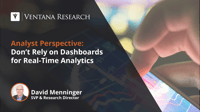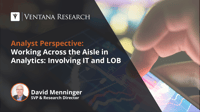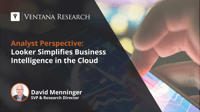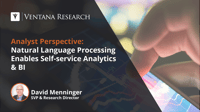I have written previously that the world of data and analytics will become more and more centered around real-time, streaming data. Data is created constantly and increasingly is being collected simultaneously. Technology advances now enable organizations to process and analyze information as it is being collected to respond in real time to opportunities and threats. Not all use cases require real-time analysis and response, but many do, including multiple use cases that can improve customer...
Read More
Topics:
Analytics,
Business Intelligence,
Internet of Things,
Data,
Digital Technology,
Streaming Analytics,
AI & Machine Learning,
Analytics & Data,
Streaming Data & Events
For years, maybe decades, we have heard about the struggles between IT and line-of-business functions. In this perspective, we will look at some of the data from our Analytics and Data Benchmark Research about the roles of IT and line-of-business teams in analytics and data processes. We will also look at some of the disconnects between these two groups. And, by looking at how organizations are operating today and the results they are achieving, we can discern some of the best practices for...
Read More
Topics:
Analytics,
Business Intelligence,
Data,
Digital Technology,
AI & Machine Learning,
Analytics & Data
Organizations face various challenges with analytics and business intelligence processes, including data curation and modeling across disparate sources and data warehouses, maintaining data quality and ensuring security and governance. Traditional processes are slow when transforming large and diverse datasets into something which is easily consumable in BI. And, it can take days or weeks to create reports and dashboards — maybe longer if processes change and new data sources are introduced....
Read More
Topics:
Big Data,
Analytics,
Business Intelligence,
Cloud
Today, organizations understand the importance of good external data that can be integrated with internal data to train machine learning models. Our Machine Learning Dynamic Insights research showed that external data adds a significant value in gaining competitive advantage, improving customer experience and increasing sales. But getting the right external data for a particular requirement is not always easy. Internal data is usually not enough to train different models because of its narrow...
Read More
Topics:
Explorium,
External Data Platform
Natural language processing (NLP) is a field that combines artificial intelligence (AI), data science and linguistics that enables computers to understand, interpret and manipulate text or spoken words. NLP includes generating narratives based on a set of data values, using text or speech as inputs to access information, and analysing text or speech, for instance, to determine its sentiment. There are various techniques for interpreting human language, ranging from statistical and machine...
Read More
Topics:
Big Data,
Analytics,
natural language processing,
NLP














